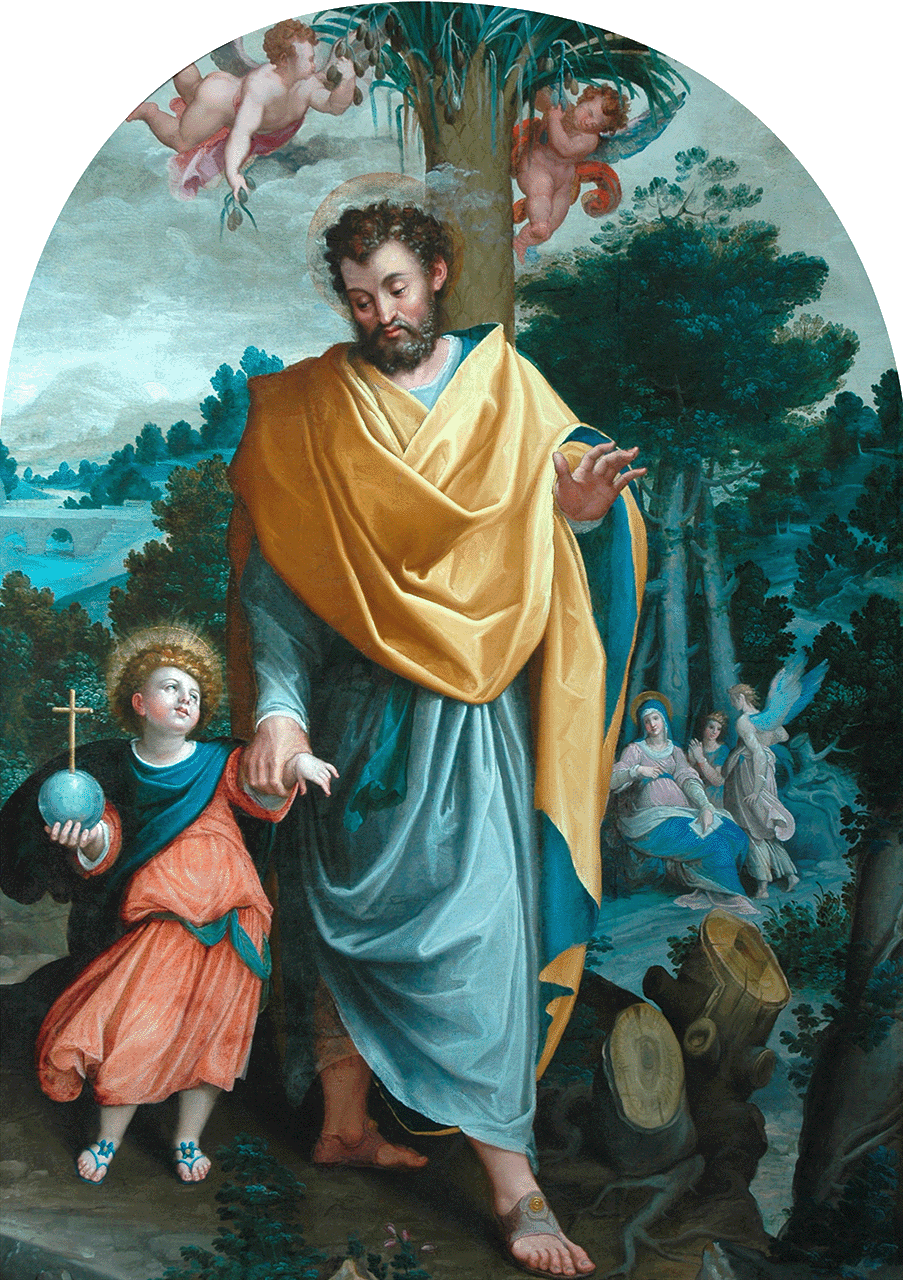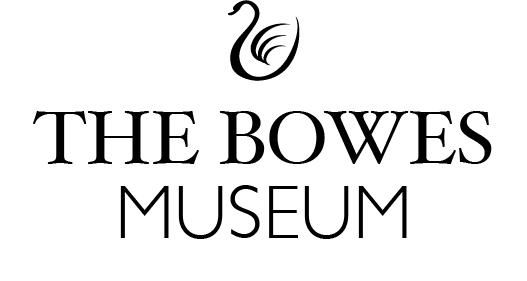
St Joseph Leading the Infant Christ
Having been warned by an angel about Herod’s plan to massacre the infant boys in his kingdom, Joseph left Bethlehem and took his wife and child to Egypt, where they remained until it was safe to return. The episode, which proved popular with artists, inspired a range of approaches. In addition to treatments of the Massacre of the Innocents—many of which fuse graphic images of child murder with expressions of maternal grief—the two most common were representations of the journey of the Holy Family, or, as is the case here, of a moment of rest along the way.
In this painting, which has been attributed to the circle of Juan Sánchez Cotán, the emphasis of composition falls on the position of Joseph as guide and protector. Depicted in full-length with a thick bushy beard flecked with tinges of grey and a yellow cloak over a blue tunic, he grips the wrist of the infant Christ with his right hand while indicating the way forward with his left. As he looks downwards towards his son, he exudes an impression not just of love and devotion, but of masculine authority and experience. By his side, Christ, dressed in blue and red, reciprocates his gaze while carrying a cross-surmounted orb that symbolizes the triumph over death and the dominion of Christianity on earth. Above their heads, a brace of cherubs pick dates from a palm tree so as to provide them with sustenance. The fact that the palm is a traditional symbol of martyrdom adds an additional element of poignancy, anticipating the Infant’s future sacrifice. By their side, the Virgin, dressed in robes of pink, white, and blue, rests in the company of angels. The book in her hands suggests the fulfilment of prophesy. Despite having avoided the fate of the mothers of the Innocents, the fact that she is surrounded by sawn tree stumps—a traditional reference to lives cut off in their prime—suggests that her joy will be fleeting.
The approach adopted in the painting counters the popular medieval perception of Joseph as a doddery old man and figure of secondary importance. Rather than draw attention to his status as an impotent cuckold who could not possibly have fathered a son, it envisions him as a vigorous man in the prime of life, assuredly embracing his roles as father, teacher, and guide. It can be related in this respect not just to works such as Jerónimo Gracián’s Summary of the Excellencies of St Joseph (1597), but to the decision of the Carmelites to adopt him as patron and the subsequent exportation of his cult to the Americas, where engraved images proved particularly popular.
The painting, which is unsigned, was previously attributed to Juan Fernández Navarrete (1526–79) but has subsequently been reattributed to the circle of Juan Sánchez Cotán, an artist active in Toledo until 1603 and then in Granada until the end of his life in 1627.
 Click to zoom and pan
Click to zoom and pan
...
Your feedback is very important to us. Would you like to tell us why?
We will never display your feedback on site - this information is used for research purposes.
Artwork Details
Title
St Joseph Leading the Infant Christ, known also as The Rest on the Flight into Egypt.
Artist
Circle of Juan Sánchez Cotán (Toledo, 1560 – Granada, 1627).
Date
c. 1590–1603.
Medium and Support
Oil on canvas.
Dimensions
221 x 156.2 cm.
Marks and Inscriptions
None.
Acquisition Details
Bequeathed by John and Joséphine Bowes, 1885.
Previous Owners
Unknown.
Institution
The Bowes Museum, Barnard Castle, B.M.69.
Bibliography
George Kubler & Martin Soria, Art and Architecture in Spain and Portugal and their American Dominions: 1500 to 1800 (Harmondsworth: Penguin, 1959), p. 379;
Eric Young, ‘Renaissance and Mannerist Painting in Spain’, Apollo, 81 (1965): 206–15 (p. 214);
Eric Young, ‘Cuadros españoles poco conocidos del Bowes Museum’, Archivo Español de Arte, 4 (1967): 204–14 (p. 212);
Eric Young, Catalogue of Spanish and Italian Paintings: The Bowes Museum, Barnard Castle, County Durham (Washington: County Council of Durham, 1970), pp. 49–51;
Alfonso Pérez Sánchez, ‘Unfamiliar Italian Paintings of the Seventeenth Century’, Apollo, 99 (1970): 364–73 (p. 358);
Eric Young, Catalogue of Spanish Paintings in the Bowes Museum, 2nd ed. (Middlesborough: The Bowes Museum, 1988), pp. 152–53;
Charlene Villaseñor Black, Creating the Cult of St. Joseph: Art and Gender in the Spanish Empire (Princeton NJ: Princeton University Press, 2006), pp. 21–39;
Véronique Gerard Powell, ‘Spanish Paintings in the Bowes Museum’, in Spanish Art in County Durham, ed. Clare Baron & Andy Beresford (Bishop Auckland: Auckland Castle Trust, The Bowes Museum, & Durham University, 2014), p. 68;
Mercedes Cerón, ‘Saint Joseph Leading the Infant Christ’, https://vads.ac.uk/digital/collection/NIRP/id/27173 [accessed: 18.07.22].
